Fines to be Imposed for Unruly Behaviour This Tourist Season in Split
May 20, 2023 - On the night from Thursday to Friday, after an exhausting fifteen-hour session, the Split City Council accepted a decision on public order and peace in the area of Split, according to which inappropriate actions in public places will be fined during the tourist season.
As Poslovni writes, fifteen councilors voted for such a decision, and one abstained - sixteen councilors present means that it was a quorum since the City Council has 31 councilors.
According to that decision, the following will be fined 300 euros: consumption of alcohol in public areas (areas less than 100 meters from schools and kindergartens, within zone A, which includes the city area within the baroque ramparts built in the 17th century; defecating on public areas, sleeping in parks and lawns, squares and other public areas, consuming food or drinking on public areas, staying in catering facilities after the end of working hours.
An amendment was accepted to fine 300 euros for climbing and sitting on monuments and memorial plaques, entering, climbing, and bathing in fountains, and offering and contracting a taxi service that is not prearranged.
A fine of 150 euros will be imposed for vomiting in public areas and construction and installation work from 2:00 p.m. to 5:00 p.m. and from 10:00 p.m. to 7:00 a.m. to prevent noise.
As explained, this decision on fines considers the media articles in the last tourist season about the inappropriate behavior of tourists in public places in Split, which caused outrage among the city's inhabitants.
This decision, as stated in the explanation, defines offenses against public order and peace in the area of the city of Split, which in an impermissible manner disrupt public order and peace, the work or the order of life of the inhabitants, obstruct movement on the streets, offend morals and threaten the general safety of people and property.
It was also announced that a tender would soon be announced for hiring security guards to assist the police. "During the 90 days in the tourist season, every night from 10:00 p.m. to 4:00 a.m., there will be a dozen security guards on hand to help the police," said Split's deputy mayor, Bojan Ivošević.
Funds for financing security guards, as it was stated, will be provided from the city budget.
For more, make sure to check out our dedicated News section.
AWFT22 Reflections for Croatia: City of Nimes, Sustainable for 2000 Years
November 1, 2022 - The second edition of the first world forum dedicated to the transformation of the tourism industry, A World For Travel, was held in Nimes, France, from 27 to 28 October. TCN was there to learn about sustainability in travel and tourism. From a journalist's perspective, there was plenty of talk that seemed unactionable or unaccessible to the everyday person. Still, the forum did achieve its primary goal and made us think about the threats that the industry is facing and the fact that there is an urgent need for a change of direction. As for Croatia, there were no representatives, but the hope is that next year's forum will bring a lot more for this tourist destination where the question of sustainability remains very important.
In TCN, we had a chance to sit with the organisers, the representatives of Bosnia and Herzegovina, Ukraine, large and small businesses that focus on sustainable travel, and other media professionals who have worked on covering this vital topic. Our interviews and reflections are coming in the following days, all with the underlying thought of how Croatia is doing and where we are headed. Before we get to that, let us share what we learned from the city of Nimes.
Nimes was chosen for several reasons: its privileged location on the Rhone Valley-Italy-Spain axis with three direct motorway exits, 2 TGV stations with connections to Paris and Roissy airport, and to the main cities and their airports, not forgetting access to the TER network.
This ancient city is where history has left its mark for 2,000 years, as evidenced by the three main monuments: the amphitheatre, the Maison Carrée, and the Tour Magne, buildings that are today among the best preserved in the world. The vast restoration project of the Nimes amphitheatre, undoubtedly the largest undertaken in France at the beginning of the 21st century, demonstrates the common will to fully assume the heritage that is the pride of the City of Nimes, to preserve it and to transmit it. This restoration concerns the entire monument and is the most important one it has undergone since its origin. It is being carried out without interrupting the public's use of the site and its use for the many shows it hosts, as it has retained its primary function as a performance venue. This project follows the equally exceptional restoration of the Maison Carrée, which took place from 2006 to 2010. This monument represents one of the oldest and best-preserved expressions of a Roman temple dedicated to imperial worship. Its remarkable architectural quality also bears witness to the values of lasting peace, harmony and prosperity that the Roman Empire promoted and sought to guarantee in the first century AD.
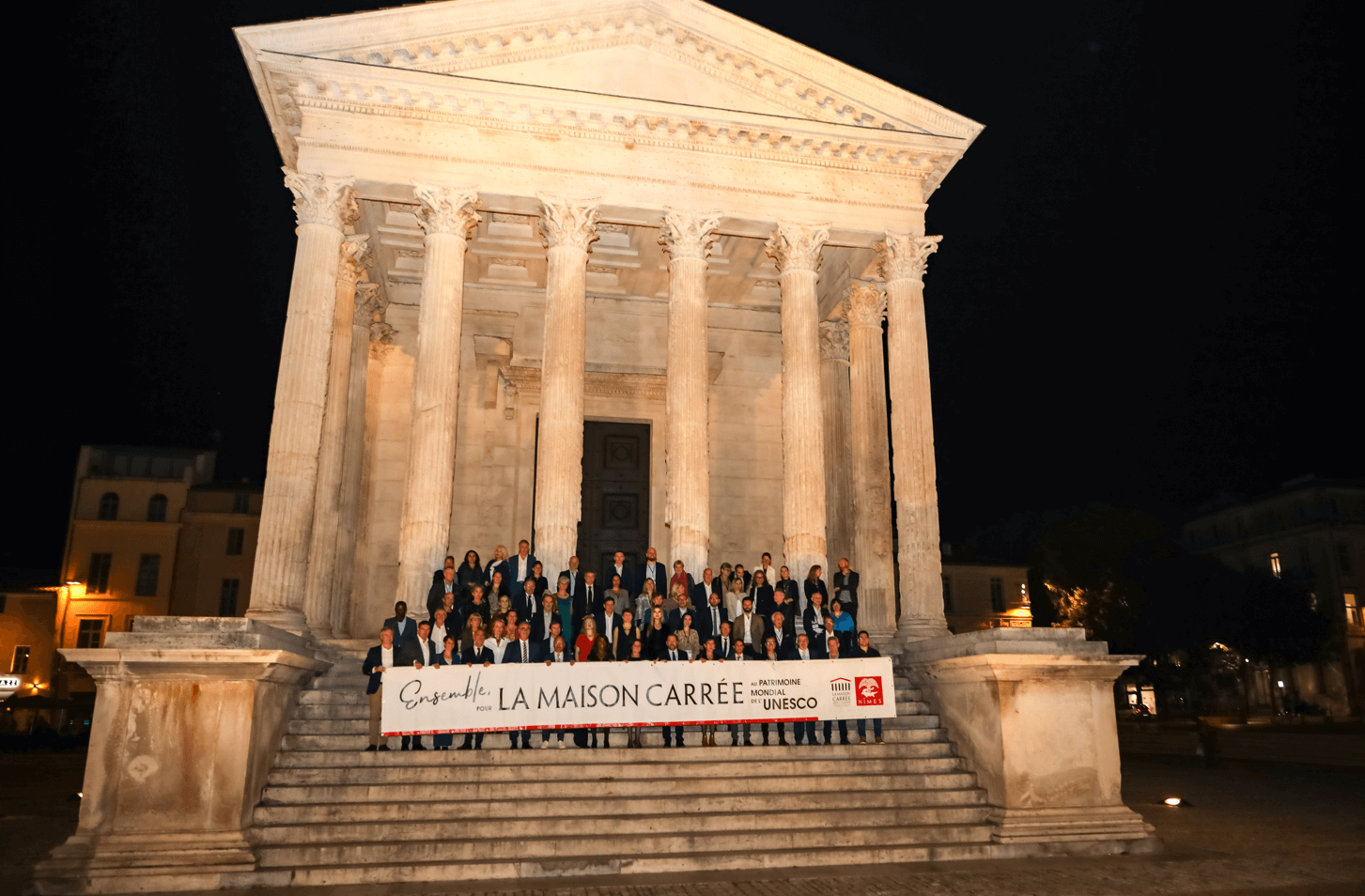
These restoration projects are all the more exceptional because the stones used are still extracted today from the same quarries used by the Romans 2,000 years ago. Did you say sustainable? The unique character of the ancient temple has motivated the city to apply for World Heritage status, an application that will be studied at the next UNESCO session. The protection of its ancient heritage, but also its enhancement, has been the backbone of the numerous urban redevelopment projects that have taken place over the last few decades.
In a constant concern to embellish and improve the living environment of the inhabitants and to make the city accessible to as many people as possible, many improvements have been made to facilitate the use of the city on foot and the organisation of events in the historic centre, not forgetting the connection with the transport network. The principle of intermodality prevails in the urban regeneration programmes and is reflected in the creation of high service level bus lines connected to park-and-ride facilities at the city entrances. A bicycle plan completes the package and is being developed in connection with the cycle paths and European routes that cross the territory.
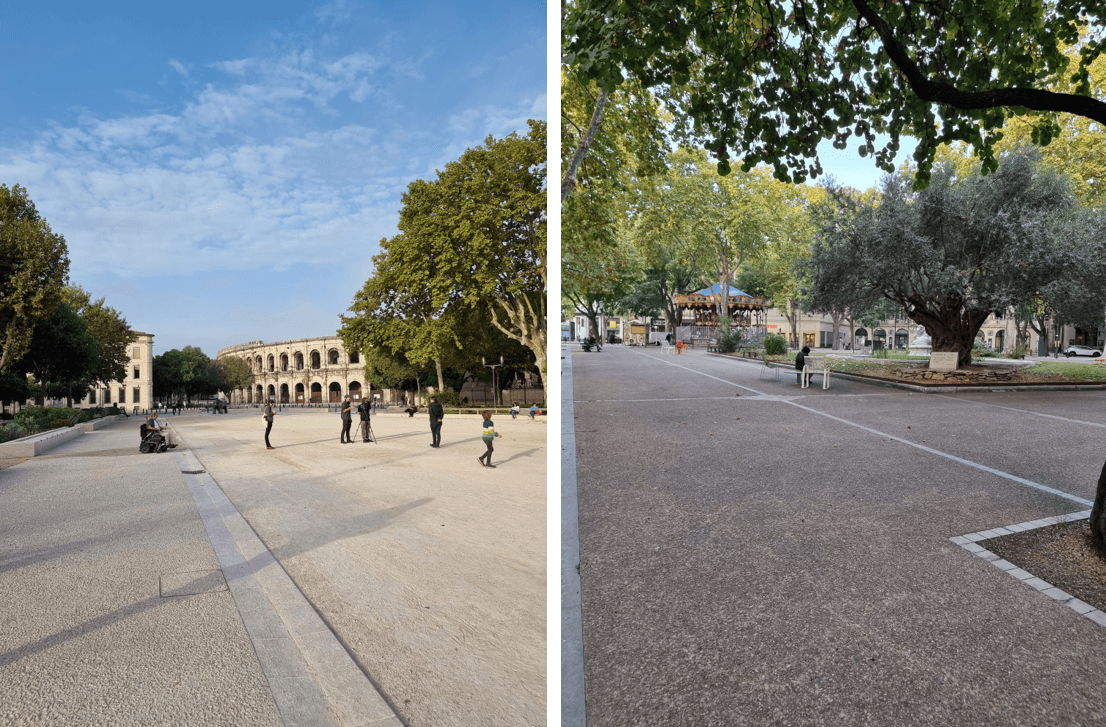
Improving the living environment and protecting the inhabitants from the vagaries of nature are priorities for the City, which has developed particularly innovative monitoring and warning tools, of which it was a pioneer. For more than thirty years, the City has been developing a substantial system to protect itself from climatic hazards and to preserve human lives as well as everything that contributes to economic development, including infrastructure. Residents, businesses, local media... all share the culture of risk and the imperative need to respect the measures provided for in the event of a crisis, in the interest of all.
Among the tools at its disposal, Nîmes has adopted a local town planning plan. While it restricts certain constructions and limits urban sprawl, it also guarantees the optimisation of buildable areas by rebuilding the city on itself. The development of numerous gardens and natural spaces, which are essential to avoid rainwater runoff, offer year-round peaceful and recreational spaces to a population that appreciates the conviviality of a human-sized territory. Designed for its inhabitants, these facilities are just as beneficial to the many visitors that Nîmes welcomes throughout the year to discover its heritage or to take part in a cultural or sporting event, or even one of the unmissable events that take place in the Roman city, such as the Emperor's Games, which take its visitors back to antiquity.
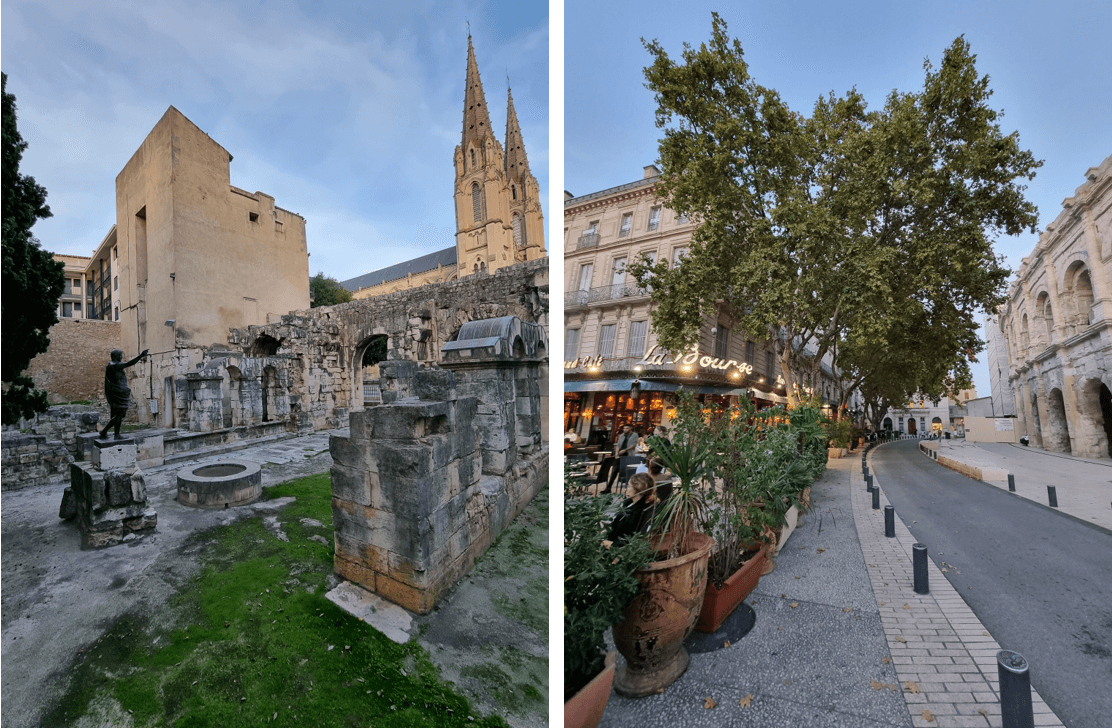
Nimes offers a calendar of events throughout the year in order to provide 4-season tourism and thus spread visitor numbers over the year. Ranked as the 8th greenest city in France according to the Green Cities Observatory and oxygenated by 372 ha of public spaces and 1,080 ha of natural spaces, it has been awarded 4 flowers in the Villes et Villages fleuris (Cities and Villages in Bloom) label and practices ecological management of its green and natural spaces, which is totally in line with the principles of sustainable development.
The city is committed to a sustainable approach with the implementation of global energy performance contracts, particularly in its museums, reducing its expenditure by more than 20% by 2021. It is also stepping up the development of its photovoltaic park and is continuing its work to obtain certification (Eco Réseau label, Sustainable Buildings Occitanie, etc.) to reduce energy consumption. The plan is to reduce the energy consumption of all its buildings of more than 1,000 m² by 40% by 2030 to comply with the requirements of the RTRénovation and RE2020 regulations.
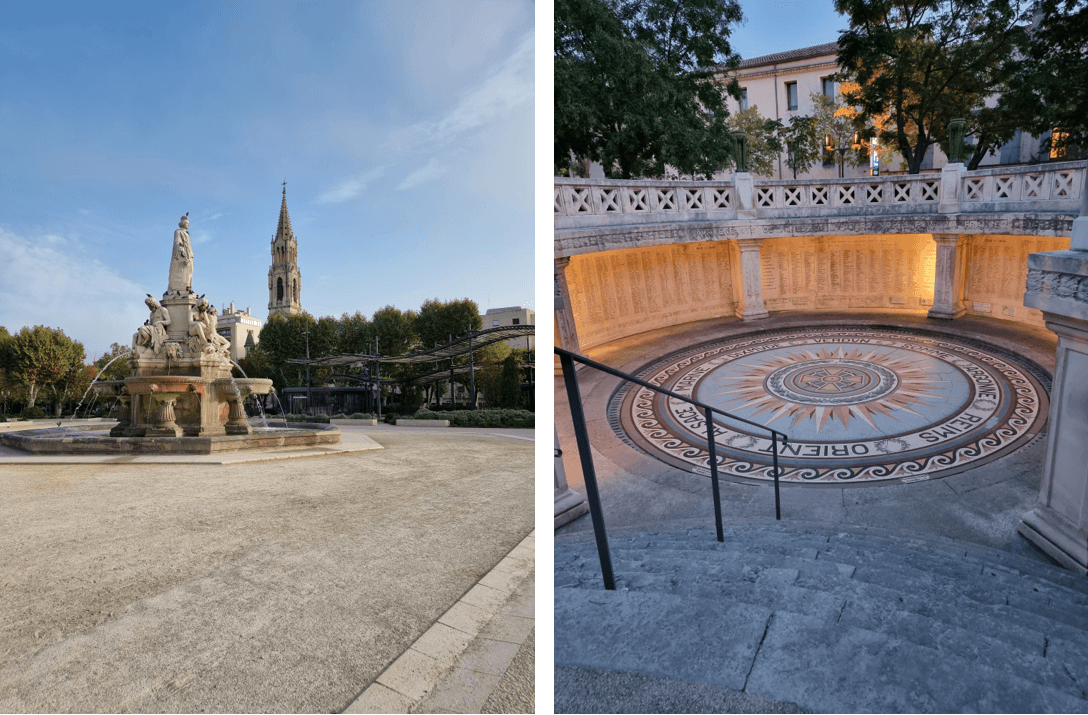
Nimes Tourism, in its capacity as a Destination Management Organisation, is accompanying the destination's professionals in a classification and labeling process, in collaboration with the CRTL Occitanie, which has placed this theme in its strategy. Already holding several labels, it is also committed to the ISO 20121 approach to strengthen its actions in terms of sustainable tourism.
In conclusion, while the participation of Nimes in the A World for Travel forum was definitely an excellent marketing move by the town's officials, it wasn't empty promises. The city of Nimes is a truly fascinating little place, where you can feel the effort that has been put into making it a sustainable destination. Lots for Croatia to learn, definitely. And Nimes is not the only place that can teach us something. Next up in our AWFT series: what our neighbours have been up to.
For more, make sure to check out our dedicated Travel section.
AWFT: BiH Signs Agreements - Cross Sector Collaboration for Sustainability
October 27, 2022, Nimes, France - The A World for Travel Forum was opened this morning with welcomes from the representatives of the partner organisations, the Occitanie region, agencies, as well as Jamaica's Minister of Tourism. The event of the morning was the signing of agreements between the Ministry of Environment and Tourism (notice how environment takes the first place) of Bosnia and Herzegovina and their partners, all on a mission to develop tourism in Bosnia and Herzegovina while focusing on sustainability. Tourism will not be an accident but a planned collaborative effort, with environment in the focus, built on the foundations of communication and partnerships between the governmental organisations and external partners. Panels of the country's representatives and interviews will follow this afternoon, but their opening did make us wonder if Croatia can still learn.
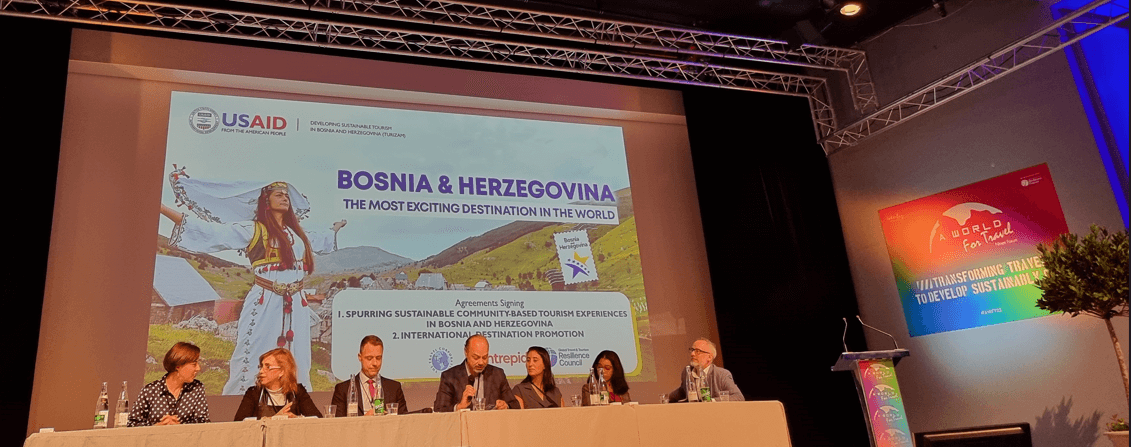
The representatives from the Global Travel and Tourism Resilience Council, Intrepid Travel, The Travel Corporation and USAID’s Developing Sustainable Tourism in Bosnia and Herzegovina (Turizam) project are signing the culmination and launch of their partnership which was born to facilitate the sustainable tourism development of Bosnia Herzegovina. The project is built on a platform of collaboration starting with the spurring of sustainable community-based tourism experiences to drive and answer increased market demand for unique experiences. The international networks of these partners will jointly work on transforming Bosnia and Herzegovina’s world-class tourism potential into a globally recognized example of sustainable tourism development. Two agreements are being signed by USAID Turizam Chief of Party Ibrahim Osta, Intrepid EMEA Managing Director Zina Bencheikh, The Travel Corporation Global Sustainability Manager Nadine Pinto and the CEO of Jacobs Media Group/The Global Travel and Tourism Resilience Council, Duncan Horton.
“We could not be prouder of the work our Resilience Council has done this year, particularly with such a positive story coming forward to share with other destinations who may be looking at repositioning sustainably,” stated Mr. Horton in a recent interview with Travel Weekly.
“Developing sustainable tourism in new destinations is a key focus for us at Intrepid and we are delighted to be working with USAID, Project Turizam and the Global Travel and Tourism Resilience Council on this project. Partnerships like these are essential as we move toward a more sustainable future for our industry,” said Zina Bencheikh, Managing Director, INTREPID Travel, EMEA. She continued,” We’re grateful to play a part in making this beautiful destination more accessible in a way that respects the history of the country, leaves a light footprint and respects and supports local communities."
The partnerships are building upon a strong foundation which includes community engagement, toolkits and consistent communication on the value of collaboration in driving sustainability. The destination benefiting from these projects, Bosnia and Herzegovina has joined the AWFT22, as they did last year in Evora to share more in depth various aspects of the project with this year’s attendees. The announcement at AWFT 22 includes the participation of Deputy Minister of Tourism and Environment of the Federation of Bosnia and Herzegovina Sabina Sahman-Salihbegovic, Secretary General of the Republika Srpska Chamber of Commerce Dragana Kokot, Deputy Director of the USAID/BiH Economic Growth Office Dr. Erol Mujanovic and USAID Turizam Chief of Party Ibrahim Osta.
Additionally, USAID Turizam Tourism Product Development Team Leader Fedja Begovic will participate in the Case Study Agriculture and the Food Industry’s Relationship with Travel, Sabina Sahman-Salihbegovic is one of the speakers at the panel Community Involvement vs. Engagement – Has it Been defined? Are the Benefits Reaching Local Communities?, Dragana Kokot will be part of the panel How to Bring Talent Permanently to the Industry?. Ibrahim Osta will lead one of the headliner sessions titled Billions Available, a session with panelists such as BpiFrance, Certares, ICF and Roland Berger which represent investment, finance and consulting global powerhouses with billions of euros in annual investments in the tourism, hospitality, aviation and infrastructure spheres. The objective of this session is to explore the most optimal approach to expand access to capital for large-scale multi-billion dollar investments and to identify challenges and solutions to smaller borrowing needs of tourism enterprises. In addition to his participation in the opening session dealing with international partnerships, Erol Mujanović will participate in the conference’s Final Roundtable slated to determine the event’s output.
"Tourism is the country's strategic sector, accounting for around 11% of total employment and one of the key generators of exports and foreign exchange. And perhaps the best embodiment of the concept of partnership is how our USAID Developing Sustainable Tourism in Bosnia and Herzegovina project is being implemented. Our delegation here in Nimes consists of the Ministry of Environment and Tourism representing government, the Chamber of Commerce representing the local private sector, two international trade partners, examples of our global partnerships, and our project leadership that works with local communities, entrepreneurs, and youth," noted Erol Mujanović, USAID/BiH Economic Growth Office Deputy Director.
USAID Turizam is a five-year project that aims to fuel broad-based tourism-driven economic growth and promote social harmony by capitalizing on Bosnia and Herzegovina’s rich cultural heritage and distinctive nature. The project aims to set the tourism industry on a robust growth trajectory toward a sustainable tourism economy with increased employment and business expansion. With the aim of generating arrivals, increasing tourism spending by international travelers in Bosnia and Herzegovina, expanding retail options for the country’s rural producers and spreading economic opportunities into secondary destinations, USAID Turizam is establishing partnerships with the following companies and organizations:
- Global Travel & Tourism Resilience Council’s key focus is to bring together the public and private sectors to facilitate collaboration and sustainability in the development of tourism strategies. Similarly, broad dissemination of collaborative efforts towards sustainability through tourism dispersion, cultural product development, experiential opportunities, local community inclusion, regional coalitions and financial parity sets a path for others to follow.
- The Travel Corporation (TTC) is a leading operator of 40 award-winning, sustainable brands, offering unique and industry-leading service that puts its guests at the heart of everything the brand does. TTC also has an extensive global distribution & marketing network to support the inward flow of business to support activities included in TTC tours.
- Intrepid Travel is a leading operator of Sustainable Experience Rich travel with significant expertise in developing experiential activities in communities and supporting various stakeholders to prepare to manage, operate and maintain their business as a supplier. Intrepid also has an extensive global distribution & marketing network to support the inward flow of business and support activities included in Intrepid tours.
For more, make sure to check out our dedicated Travel section.
AWFT: A World For Travel Global Travel and Tourism Forum in Nimes, France
October 26, 2022 - The renowned A World for Travel (AWFT) event will take place in Nimes, France, on October 27-28, 2022, celebrating its 2nd year.
As stated in the official press release, the Forum announces the Egyptian government providing a preview of COP27. Ukrainian officials will share how destinations cope with war and protect their tourism assets, while Google will deliver new traveller trends. Ministers of Tourism will participate in discussions sharing groundbreaking initiatives. The two-day event, designed in a Davos-style manner, is aimed at transforming the travel industry and all those serving the traveller to become sustainable in all aspects of their businesses: environmentally, socially, economically, and climatically. Produced in conjunction with the Global Travel and Tourism Resilience Council, the A World for Travel organisers are working globally to ensure the travel industry and all associated businesses operate sustainably.
Thought leaders from global enterprises such as Mastercard, Costa Cruises, Pierre et Vacances, ICF, Amadeus, World Bank, Delta Airlines, Europcar, TUI, American Express GBT, SNCF, Alstom and Accor will join public sector officials, including Ministers from France, the EU, Scotland, Jamaica, Bosnia, and Herzegovina, Moldova and Portugal to determine “how” to make travel more sustainable.
The event moves into its second year partnering with the 3,000-year-old city of Nimes in the South of France, where the city is “set to become one of Europe’s outstanding examples of sustainability,” announced Jean-Paul Fournier, the Mayor of Nimes. The city’s efforts are supported by the regional government of Occitanie. “With the support of the local community, the event will deliver clear guidance on the development and management of sustainable destinations, how to address the human aspect and impact on a destination, its economics, and adaptation to climate change,” shared Christian Delom, Secretary General, AWFT.
About the Global Travel and Tourism Resilience Council
In 2016, the Global Travel and Tourism Resilience Council was launched. The Council is a global platform to bring together the public and private sectors, addressing crisis management, preparedness, recovery, and resilience. As an international thought leadership forum, the Council facilitates dialogue and works with best-of-breed companies to benefit destinations and the global travel industry. More information at resiliencecouncil.com.
About A World for Travel
A World for Travel (AWFT) is aimed at transforming travel to preserve, globally and locally, at the same time and for the same purpose for humanity and the planet. A World for Travel allows all tourism stakeholders to react, take initiatives, reshape the tourism product to meet climate, digital & social requirements, develop a positive image brought by tourism, fix the ongoing milestones to make it happen, create a common platform to share best practices and perspectives by involving all stakeholders with mixed interests and identifying threats to travel development.
Follow along for coverage, interviews, insights into how Croatia has been performing, and more with TCN.
For more, make sure to check out our dedicated Travel section.
Croatia Presented at SITEV International Tourism and Travel Fair in Algeria
October 5, 2022 - For the first time, Croatia participated at the International Tourism and Travel Fair SITEV in Algeria. The Croatian stand was extremely popular and additional tourist brochures were requested. Many questions were asked about Croatia, which showed that there is great interest for our coast, as well as continental destinations. It's no secret that Algerians consider Croatia a friendly country, they admire its coast and warm sea, they know a lot about Dubrovnik, Luka Modrić and Croatian football.
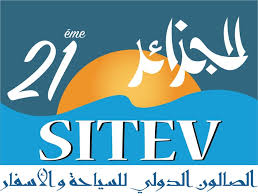
"Nothing comes by chance. At the end of last year, our Minister of Foreign Affairs Gordan Grlić Radman visited Algeria. The reception was exceptional and they opened the door for cooperation wide. They decided to develop their tourism, and Croatia can help them in every way, from nautical tourism to hotel industry. We consider our participation in the fair to be the opening of Croatia to their market
which could be a "win-win" situation. I am grateful to the Minister of Tourism who supported the idea of going to the fair, as well as the Croatian Tourist Board", highlighted Ilija Želalić, the ambassador of the Republic of Croatia in Algeria.
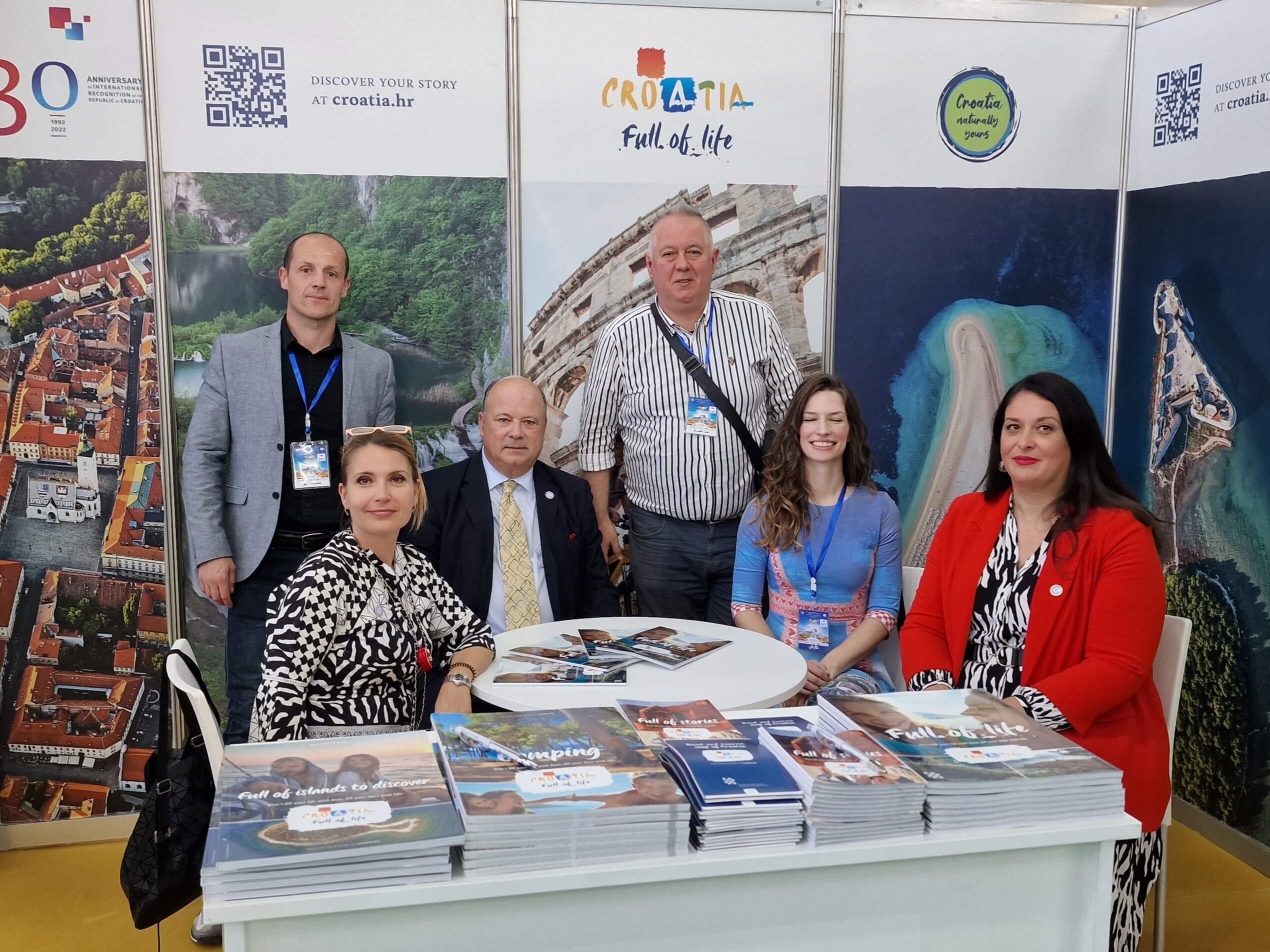
Photo: Slobodan Kadić
He is especially pleased that Croatian tourists are also visiting Algeria, specifically, recently about fifteen people visited the Sahara via Croatian agencies, and it is precisely this area that they want to promote as a tourist destination. Two years ago Croatia and Algeria exchanged the text of an agreement in the tourism segment that could be signed quickly, and after that many things will happen faster. Višnja Letica, the advisor of our ministry and the delegation from the Croatian Tourist Board all travelled to Algeria for the 21st SITEV. They made sure that our stand looked beautiful and handed out traditional Licitar hearts.

Photo: Slobodan Kadić
"Algeria has opened the doors of cooperation for us, and through Algeria we can also go to the west coast of Africa. They will build a high-speed railway to the border of Niger, Mali and Senegal... Our products could be exported there, and there is always the possibility of a free trade market among African countries, just as we, in addition to the EU, also have agreements with some countries from before. This is an advantage that many do not know about or show no interest in. Regarding obtaining Croatian visas, not every traveller is a potential migrant. Many Algerians travel around the world, have Schengen visas, and we would very much welcome such clientele. This is how they promote our tourism, which encourages others to come and enjoy our sea and its beauty", concluded Želalić, stressing that in the future it will be possible for investors from Algeria to invest money in tourist facilities and marinas.
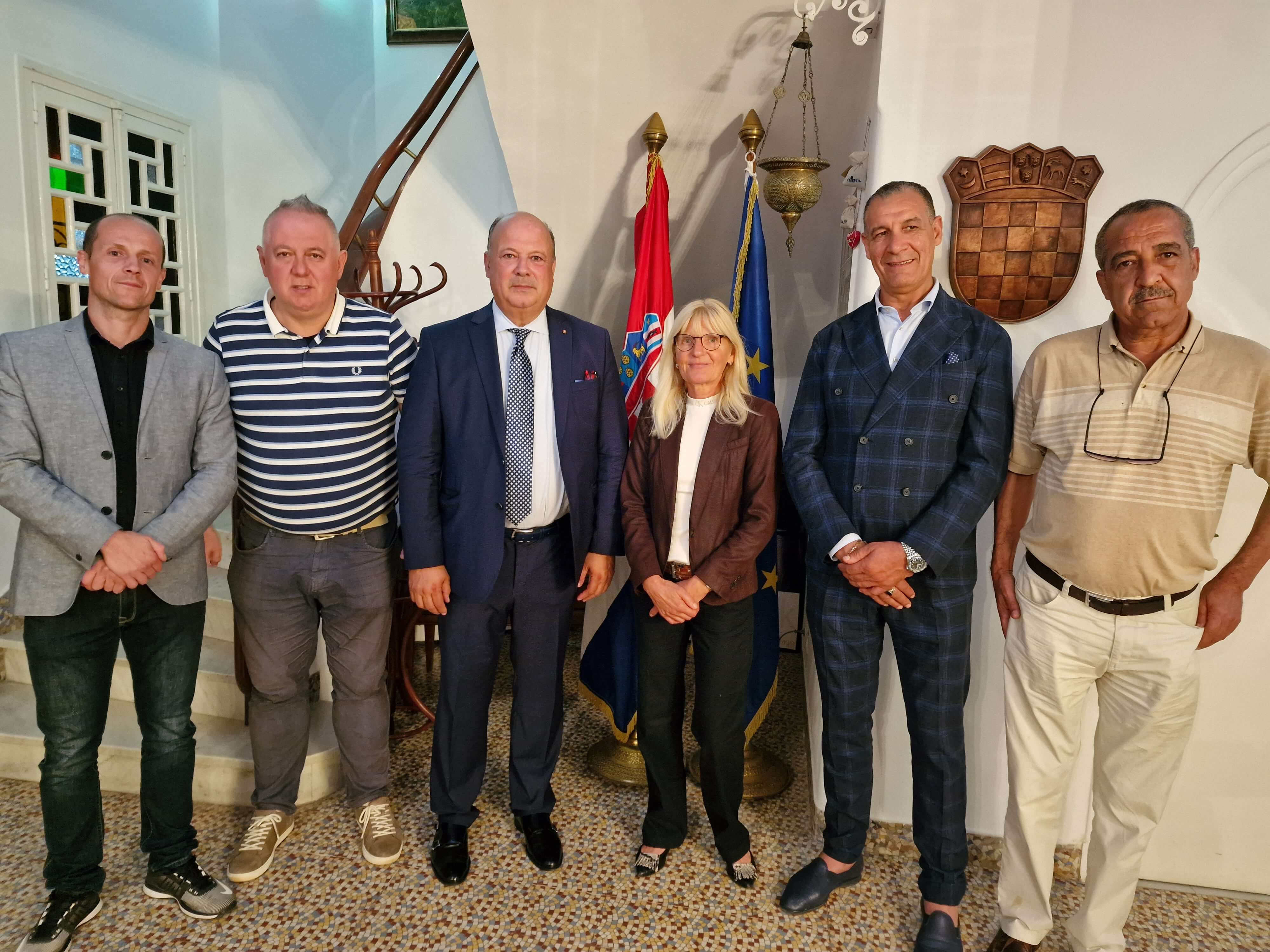
Photo: Slobodan Kadić
This year's SITEV was the 21st in a row and lasted from September 29 to October 2, 2022, and is considered the largest international tourism fair in the Maghreb countries. Alongside with several neighboring countries, Turkey participated. We are witnessing excellent growth of tourism after the coronavirus epidemic, and Croatia's participation in fairs of this type is a step forward in the additional promotion of our ever-improving tourist offer.
Croatia is in fashion
"Wherever I went, Algerians would say that Croatia is in fashion. They watch a lot of French television, and there are countless travel series about Croatia. They know a lot about Plitvice, Dubrovnik, Split and our football. A friendly soccer match between Algeria and Croatia had also been arranged, but since they were eliminated by Cameroon and are not at the World Cup, instead of playing against them, we will play against Saudi Arabia. Algeria is a promising country and I am convinced that we can achieve a lot in cooperation", said Ambassador Želalić.
For more, make sure to check out our dedicated Lifestyle section.
48 Hours in Osijek: Slavonian Pot of Content
30th of April 2022 - Green City, Lega City, Bike City, a City on Drava River... Osijek has earned a lot of names through the years and today is one of the most contemporary places in Croatia. A look into how you can spend 48 hours in Osijek.
In recent years, TCN wrote on multiple occasions about how the city of Osijek has every characteristic of a modern European town - culture, history, recreation, developed IT sector, student city with a lot of youth, enormous potential, and so on. Furthermore, the tourist offer became so diverse in the last few years that Osijek became a city for everyone.
For this list, we decided to split time frames into two sections: day one, which would be reserved for relaxing exploration of the city, and day two, for more recreational and exciting options. Now, without further ado, let’s start our 48 hours in Osijek guide!
9.00 a.m - 10.30 a.m
Every good day needs to start with a good breakfast and what is better than Restaurant Waldinger’s cuisine? Very few. Cozy ambient, calm atmosphere, great food, and the beautiful Osijek Co-cathedral of St Peter and St Paul just down the street with breakfast that stems from Slavonian and traditional to modern and worldly. For day one, we definitely suggest Waldinger.
Day two can start with something stronger - food on a stick. Fast food and street food restaurant Hokus Pokus is located just down the street from the previous selection and serves everything from breakfast to dinner. Meaty products aren’t the only food available - veggie options are also proudly displayed in this urban restaurant. Tortillas, kebabs, ćevapčići, and tasty salads are truly a good start for an active day in Osijek.
11.00 a.m. - 1.00 p.m.
Day one can be spent in various ways - just stroll through the city on foot and visit numerous green parks like King Petar Krešimir the Fourth Park that’s surrounded on all four sides by beautiful maple trees and King Tomislav Park which connects European Avenue and Tvrđa with its beautiful row of poplars. Since you’re already there, why not use that opportunity and visit, already mentioned, the old town of Osijek, Tvrđa. It’s the best-preserved ensemble of Baroque buildings in Croatia and has a Habsburg star fort built on the right bank of River Drava. Tvrđa also has a culturally rich Museum of Slavonia, that consists of art and heritage stemming from baroque to recent creations.

Tvrđa (photo credit: Mario Romulić)
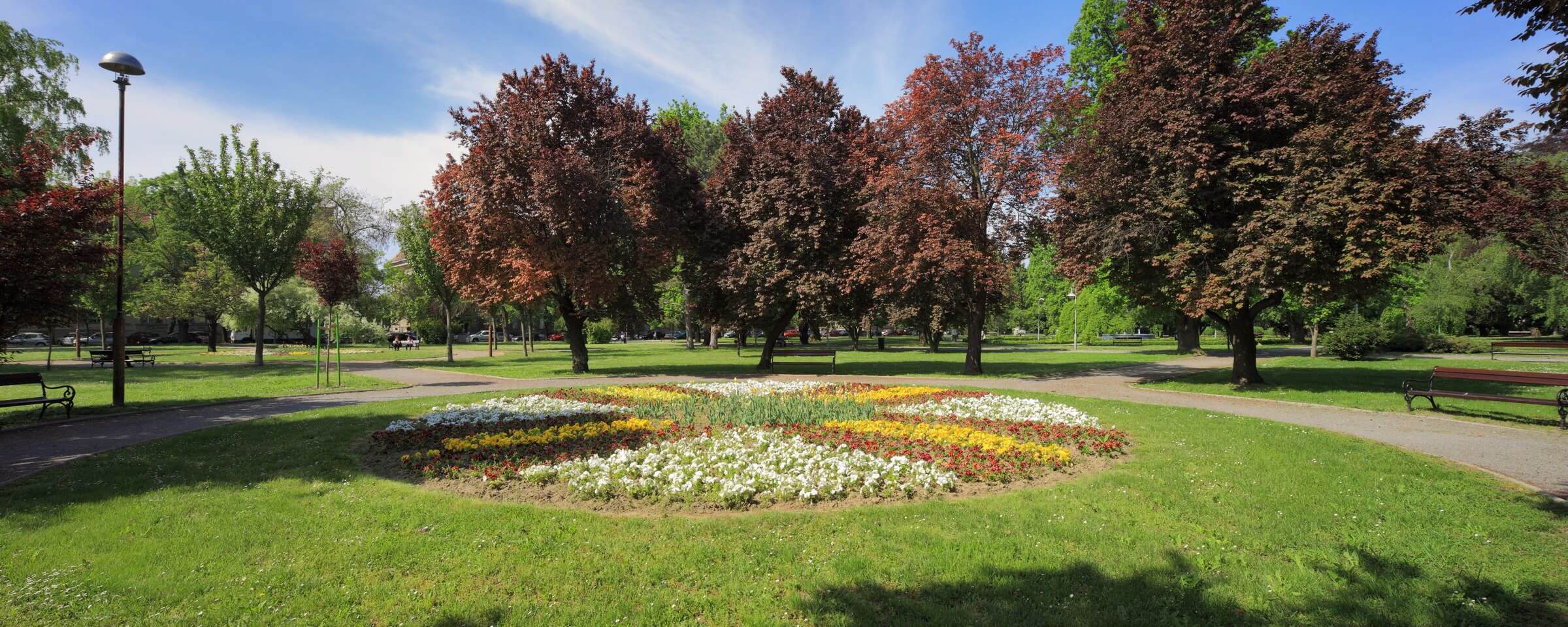
King Petar Krešimir The Fourth Park (photo credit: Mario Romulić)
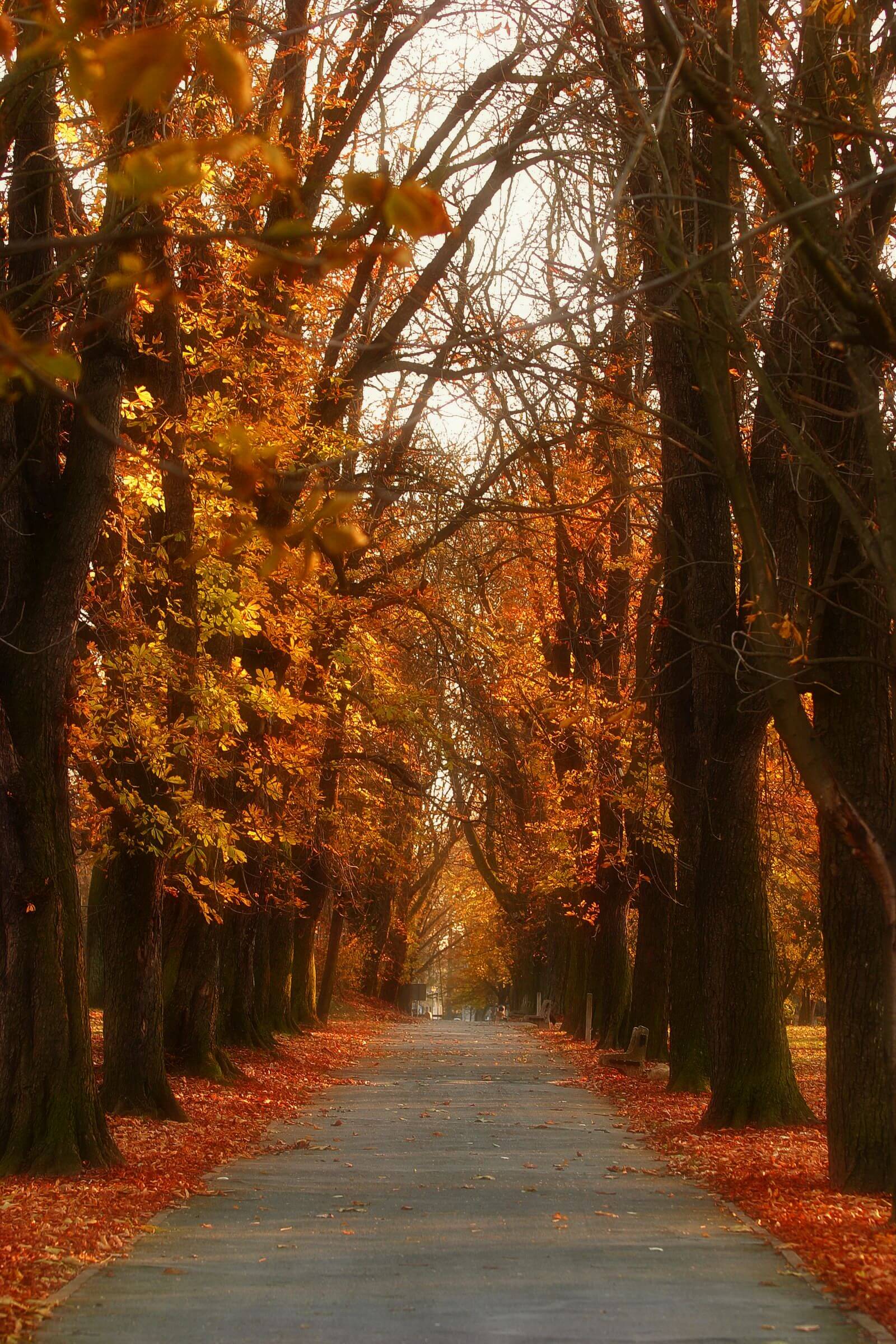
King Tomislav Park (photo credit: Mario Romulić)
After Tvrđa, use that time to sit down and have a cup of coffee - an obligation that’s never skipped in Croatia with the view of the Museum of Slavonia, faculties, schools, and old Churches of Saint Michael and Holy Cross.
The recreationally active day two can be used for biking through the city - Osijek has one of the most developed bike tracks in Croatia so if you’re even a little bit interested in being active while on holiday, biking through Osijek is a must.
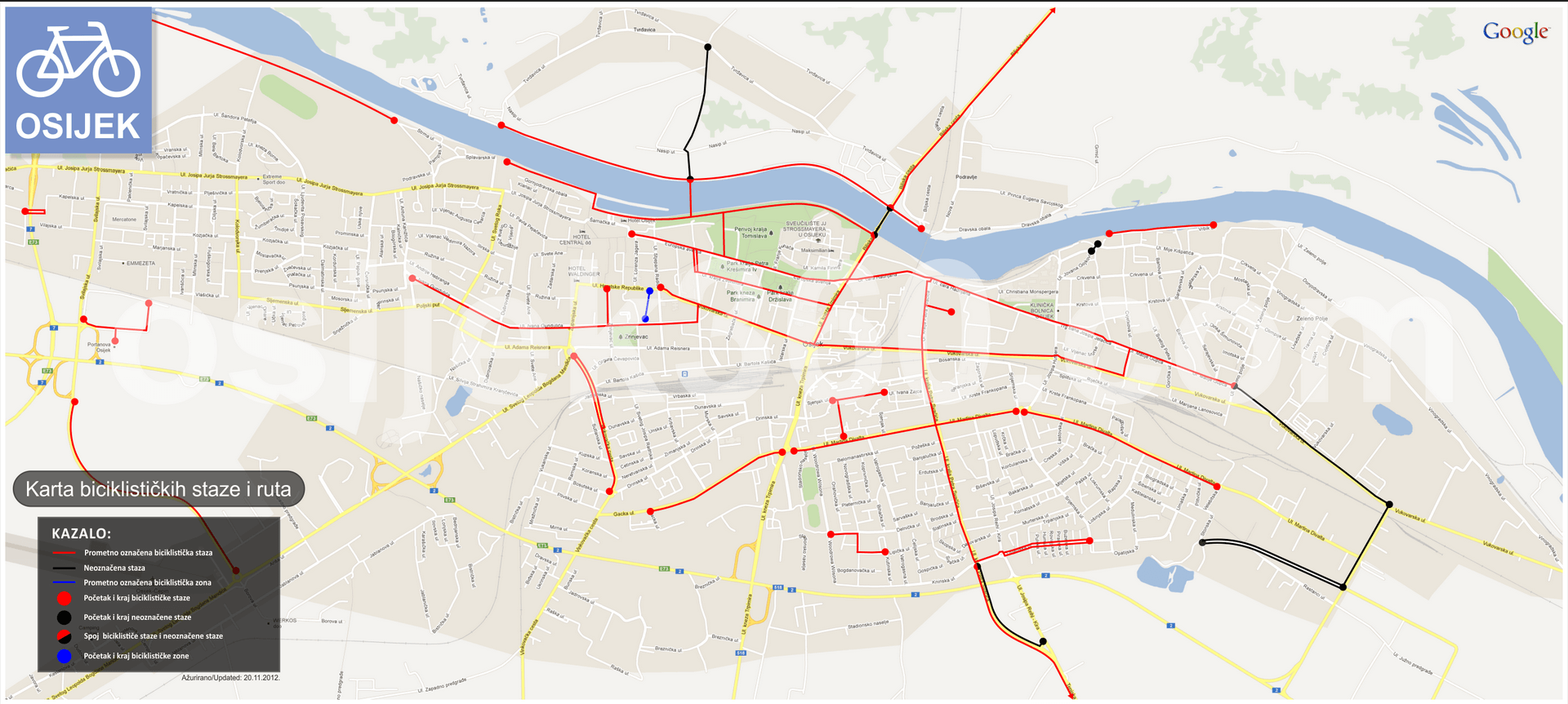
City bike routes (screenshot: www.osijek360.com)
While you're biking, cross River Drava over the popular "Bridge of youth", now symbols of Osijek, or take "kompa" and go to Osijek ZOO. "Kompa" is one of the symbols of Osijek as well - a means of transport powered only by Drava River currents transporting residents of Osijek since 1916. There's another option: take both! You can transport your bikes on "kompa" as well.
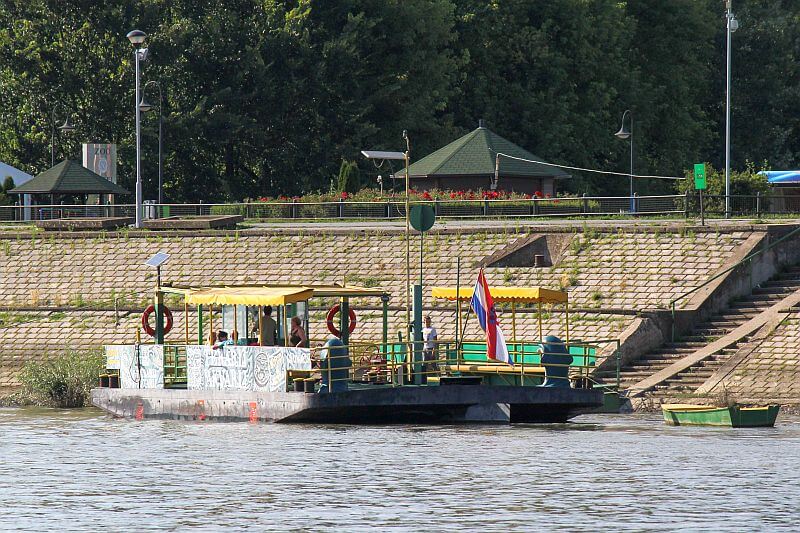
Popular "kompa", faithful "carrier" of Osijek residents since 1916 (photo credit: www.tzosijek.hr)
Osijek ZOO has been founded in 1955 and thanks to the location away from the city noise, it’s the perfect place for the peaceful stay of 80 species of animals. Next to the ZOO, there’s a hotel and catering facility with a children’s playground and a view of River Drava. All of that is near the beautiful Podravina forest.
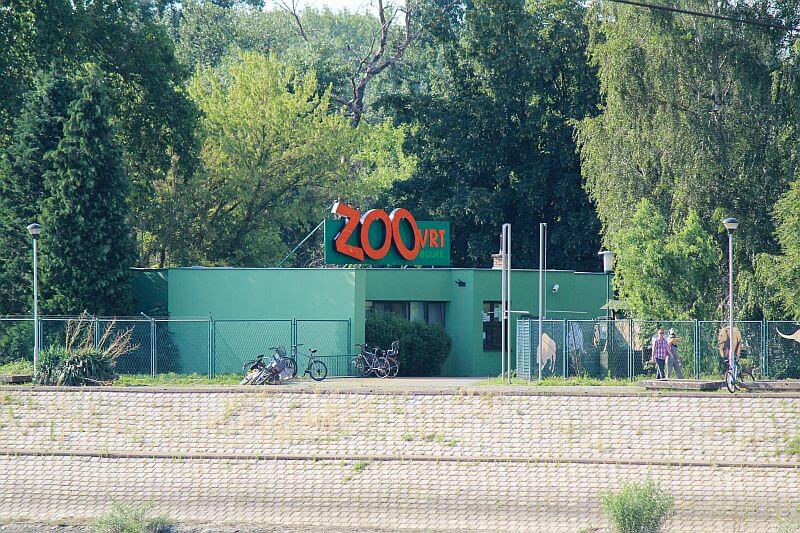
Osijek ZOO (photo credit: www.tzosijek.hr)
2.00 p.m. - 4.00 p.m.
After some sightseeing, day one should surely feature a really good lunch. If you’re near Tvrđa, definitely check out El Paso for traditional Slavonian food and strange location - on a boat on Drava River! Restaurant and pizzeria Strossmayer no.2 is located near Drava River and has already mentioned traditional dishes, however, they have multiple options like dishes from all over Europe, great pizzas and many more, with amazing Slavonian wines like pinot, chardonnay, merlot and graševina.
Options outside Tvrđa are located near the center of Osijek and its Downtown like restaurants Zeleni Val and Makedonka which are battling for the title of best čevapćići in Osijek. It’s for you to decide, Slavonians are still discussing. All of that soaked with the famous black Radler from Osječko? Name us a better combination.
More active day two requires a healthy amount of heavy food (which is a blatant oxymoron) so why not visit pubs which are definitely not lacking in Osijek. Rich beer culture always comes with pub food that can only be found in Croatia. So why not try local beer brews like American Pale Ale, Irish Dry Stout, and Czech Pilsner from Beckers Craft Brewery with homemade hamburgers that make you salivate? Few options are available: Merlon Pub located in the heart of Tvrđa, there is American Bar Dollar in the center of Osijek, and many more.
5.00 p.m. - 7.00 p.m.
After stuffing yourselves with Osijek cuisine, your 48 hours in Osijek can't pass without more sightseeing and why not use that time to visit famous European Avenue. At the beginning of the century, Osijek was the “stage” for European trends in architecture and the biggest trace left Art Nouveau. Walking on the Avenue, you’ll witness magnificent urban villas from that time with the Main Post Office and Urania Cinema, which is one of the oldest working cinemas in Croatia. On the way, visit Sakuntala Park - a specific park that has a sphinx at the entrance. Strange, isn’t it?

Museum of Fine Arts Osijek located on European Avenue (screenshot: www.mlu.hr)

Art Nouveau villa at European Avenue in Osijek (photo credit: Mario Romulić)

Cinema Urania (photo credit: wikiwand.com/Arhitektura_secesije_u_Osijeku)
On the way, you have already mentioned the beautiful Osijek Co-cathedral of St Peter and St Paul which is an ultimate symbol of Osijek. One of the most important people in Croatian culture, Osijek native and icon, Josip Juraj Strossmayer, gave the initiative to build this magnificent neo-gothic building in the 19th century that still stands tall even today. Besides Zagreb Cathedral, Osijek Co-cathedral is the tallest one in Croatia - its grandiose appearance and ethereal atmosphere bring you back to past forgotten times.

Osijek Co-cathedral of St Peter and St Paul (photo credit: Mario Romulić)
The active second day can be continued with biking near the Drava River, Podravina forests that astonish with its greenery, and used for refreshment on the famous Osijek beach on Drava River Copacabana or how locals call it, “Kopika”. This famous beach went through multiple renovations in recent years and today offers various options for relaxation and hanging out with your friends. If you’re up to it, get rid of your bikes and put on your swimsuits because this feature in our 48 hours in Osijek guide, is most certainly a must.
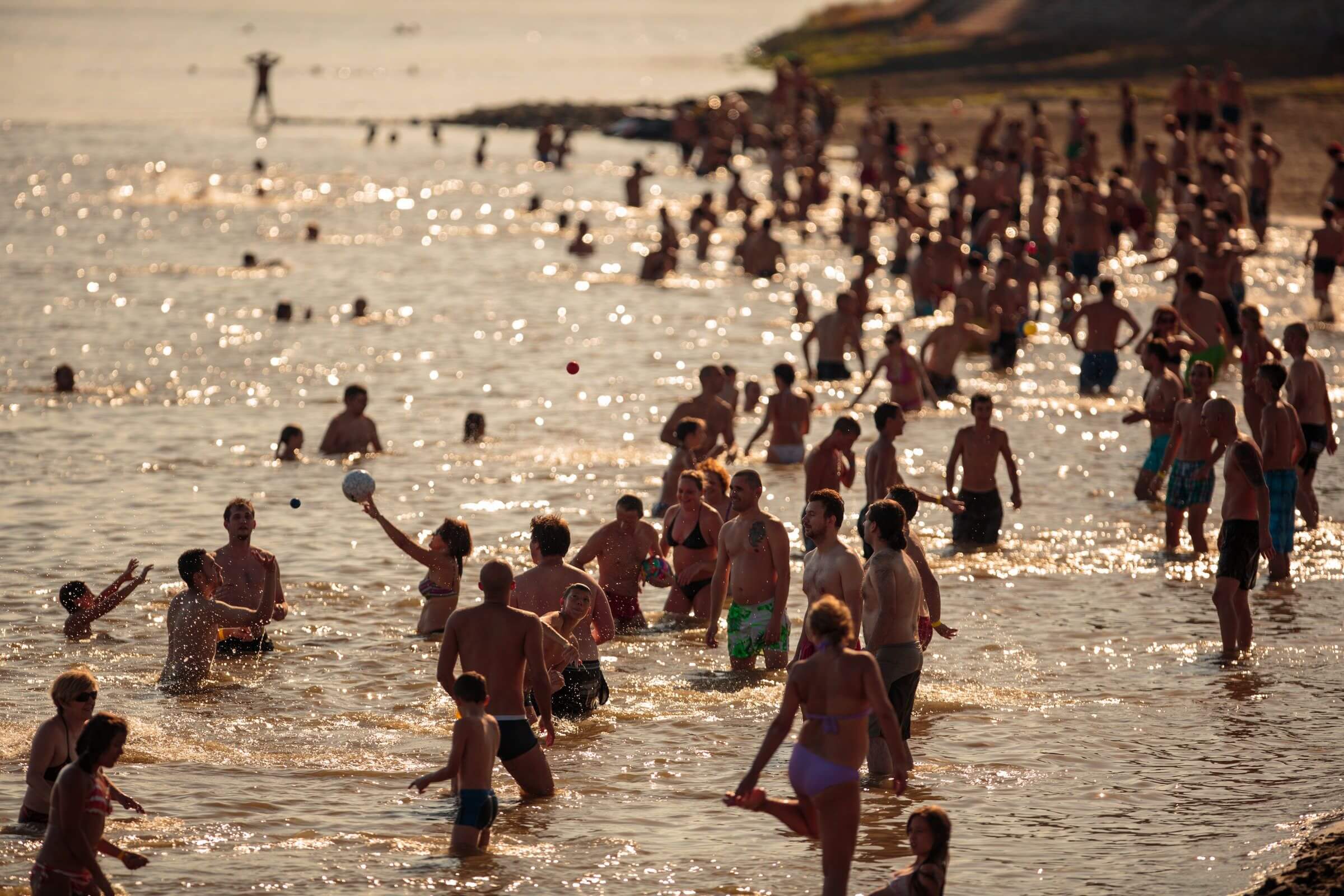
Famous Kopika (photo credit: Mario Romulić)
8.00 p.m. - onwards
After refreshments, it’s time to explore the nightlife in Osijek. This section is for both days in one since options are plentiful and, in most cases, you won’t make a mistake. However, these are the most famous ones that can make any list in Croatia. Definitely visit Radić Street which is teeming with pubs of all kinds and some of them are named after famous European cities - Barcelona and Amsterdam. In the recent past, there were New York and London but unfortunately, they haven’t survived. Even with those two gone, Barcelona and Amsterdam are still the ultimate picks if you want to see where the urban youth of Osijek and other parts of Slavonia love to go. Also, pub quizzes are amazing.
For drink/cocktail connoisseurs we recommend The Craft Room. The Craft Room bar is located right in the center of the town of Osijek. This concept bar is unique in this region because they offer a wide range of Gin and Whiskey from all over the world. Creative cocktails with innovative ingredients and award-winning bartender Miroslav Kljajić make this bar an unavoidable place to visit.
Beer lovers, do not fret! Gajba, a pub and tasting room, has every beer you want. From pale ales, lagers and so many other homegrown and worldly types of beers, this place is heaven for people who want to explore beer culture, not just of Osijek, but any European brew. If you want to visit soon, come just in time for the Craft Beer Festival that’s organized by, you guessed it, Gajba Pub.
If you think that’s all, it isn’t. Real nightlife is located in Tvrđa, where multiple nightclubs like Memories, Q Club, and more attract youth from Osijek and beyond. Foreign and domestic music “strikes” in all directions but one is an odd one out. If you want to hear Croatian live music tamburitza, go to Fort Pub - the Slavonian atmosphere and excited people make this place even better.
The end of the 48 hours of Osijek is almost done but not before leaving you visit Gold by Waldinger and Slatka Tvornica for some Slavonian sweetness - krempita, cakes, traditional Slavonian sweets, and a cup of coffee with travarica on the side? You can't go wrong.
We will end it here. This is our 48 hours in Osijek and hopefully, this guide will encourage you to come to visit Osijek, the heart of Slavonia. We deliberately left out nature park Kopački rit and the Baranja region because we wanted to emphasize how the city itself has so many things to offer. Still, that doesn't mean you shouldn't visit Baranja and the nature park because, at the end of the day, everything's connected. When talking about Osijek or Slavonia, people always say that the city or the region is underrated. I truly think it's not. What makes this area so beautiful and attractive to visitors is that people are not burdened by unrealistic expectations: we will never have tourist offers like Dubrovnik, Dalmatia, and Istria or the beautiful Adriatic Sea. We know our worth and that's why most of the time tourist goes home with a smile on their face. Charm, humility, and accepting people with open arms are our best tools. That's why Osijek is not underrated - it's properly rated.
Interested in bike tours of Slavonia? Check this article.
For more on travel in Croatia, follow TCN's dedicated page.
Staničić: Booking Is Slow, But Without Major Disruptions To Travel Market
ZAGREB, 3 March 2022 - The booking for tourist accommodation in Croatia is currently somewhat slow, but without any major disruptions to the travel market, Croatian Tourist Board (HTZ) director Kristjan Staničić said on Thursday.
He said it was very hard to make any forecasts right now considering the Ukraine crisis and its impact on present and future tourism trends. "Unless the situation in Ukraine stabilizes soon, it is realistic to expect that the crisis will start to spill over to countries in its immediate vicinity and then to the rest of Europe," he added.
Staničić said that this year Croatia could hardly count on visitors from remote markets, such as the United States, Canada, and China, who see Europe as a single destination. On the other hand, Croatia could benefit from the fact that it is primarily a car destination, easily accessible by road, which in the present circumstances is a comparative advantage.
Staničić relayed today's statement by the European Travel Commission, of which he is vice-president, in which the representatives of national travel organizations condemned the Russian military invasion of Ukraine and expressed solidarity with the people of Ukraine.
"ETC strongly condemns this violation of international law and calls for all parties to work towards a peaceful resolution," Staničić said, adding that all ETC members and partners were called upon to help by providing transport, shelter, and food to those in need.
ETC believes that the conflict will have a negative impact on the travel and tourism sectors in European countries, which are slowly beginning to recover from the COVID-19 pandemic, Staničić said.
For more on travel in Croatia, follow TCN's dedicated page.
My Two-Day Adventure From Ivankovo to Zdenci: Travel Connection Issues in Slavonia
February 10, 2022 - After World War II, a lot of people migrated from Dalmatia, Herzegovina, and more to Slavonia looking for better lives. They mostly traveled with coal-fired trains that would take a week to get to their destination. However, that was in the 1950s and 1960s. In the 21st century, in 2022, my trip to Zdenci, a village located in the east of Virovitica - Podravina County, took me two days by public transportation - train. A look into the travel connection issues in Slavonia in the 21st century.
Railways and trains, as public transportation and a part of the economy, always had a huge role in Croatian history. The first railways in the territory of today’s Republic of Croatia were built in the 19th century, which connected Međimurje with Hungary and Slovenia, only 35 years after the first railway was built in England. Croatia, which was part of the other reigns at that time, realized its potential as a favorable traffic center that connected Southern Europe with the West and more. Slavonia has become part of one of the most important railway tracks named Corridor X - a Pan-European line that goes through Vinkovci, a city that became one of the most important railway centers in Europe. Older workers fondly remember tons and tons of cargo going through Vinkovci and full trains which would transport passengers every 4 minutes. They also highlight the extended travel which was caused by worn-out railways which can’t withstand newer locomotive trains and that impact can be especially seen on Vinkovci - Zagreb line. Because of that, the consequences were inevitable and the most loyal passengers switched to other types of transport.

Screenshot: Google Maps
Ivankovo being so close to Vinkovci benefited a lot in terms of connectivity and availability of lines and trains for traveling. Every hour there would be a train transporting to a specific destination. I have travelled by train my whole life. It is my favorite type of public transportation by far and still a huge part of life, not only mine but of every other resident of the Ivankovo district.
Finally, this is how my adventure started. My friend from Osijek and I decided to visit a mutual friend who lives in Zdenci and the only time we could go was Saturday, which is a doomed day for public transportation in Croatia - lack of lines in all available public transportation. However, that didn’t stop us, this is it, we’re going, now or never. After exhausting brainstorming, I decided to come a day earlier to my friend’s place, sleep there and catch a morning train to Zdenci - Orahovica. That was the only train in the morning that traveled for an hour and a half to our destination. How? Well, the line is originally going to the city of Virovitica and it stops in the city of Našice where it stays for almost an hour?! In the end, it was less than that but before that, we didn't realize why we stopped for almost half an hour in a village called Koška. God only knows why, but apparently, we waited because of the other train that was coming back on the same railway? I still don’t know the reason why.
After we finally started traveling again, there weren’t any obstacles in our way. We were finally coming to our destination. Unfortunately, there was another problem. Apparently, the station’s location isn’t in the city of Orahovica or the village of Zdenci, it’s in another village - Duga Međa. The walk to Zdenci, with half of the way without a footpath, takes approximately 40 minutes. Of course, we shrugged that possibility off and decided on a taxi which isn’t even in Orahovica or Zdenci - it’s in the village of Čačinci. Yes, another name of the place that even made our heads spin, I can only imagine the person reading this.
Back to the story. The taxi guy from Čačinci welcomed us, props to him, and drove us finally to our friend’s house. It was a great moment; we haven’t seen each other for over a year because of the pandemic and life in general. We talked, laughed, and hung out like the old times but the lack of public transportation had to cut our time together short. There was only one train available to Osijek around 3 pm that we couldn’t miss, because of my transportation home from Osijek to Vinkovci and friends' other plans. I traveled two days for two hours of socializing. It hurt so much. After slow travel to Osijek and finally coming to Vinkovci and realizing there isn’t any public transportation to Ivankovo after 3 pm, not even a bus (which is a discussion for another time), I took a taxi and paid another fee. I came home and my mother told me: “You traveled for two days to a place that takes an hour and a half by car, and hung out with your friends for two hours?! This looks like the 1960s, not 2020s.” And I looked at her and realized she was right.
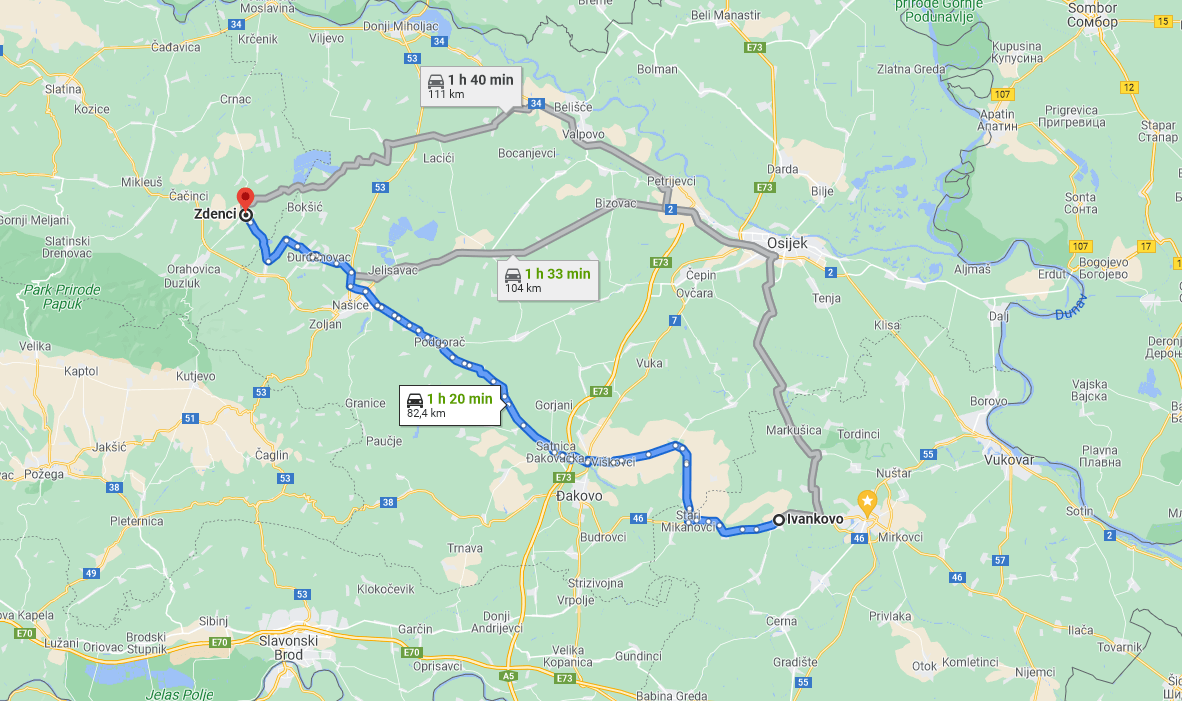
Screenshot: Google Maps
In the end, one more realization popped up in my head. The amount of money I spent going to Zdenci by train, with taxi fees and everything else, I could’ve easily paid for a cheap, discount flight to another country or go to Dubrovnik or Split by plane, possibly, even a discount two-way ticket. This wasn’t cross-country travel, we were literally going to another Slavonian place, which yes, seems far but it’s truly not. From Ivankovo to Zdenci, traveling by car, on the D515 road, that goes by the city of Đakovo, takes around an hour and a half (82,4 kilometers). From Osijek to Zdenci, it takes an hour without traffic (around 70 kilometers) and the railway has the same route as the roads and it took four hours more, including the travel back. This isn’t how it was before. How can we travel longer in 2022 than in the 1980s?
Slavonia always lived on railway infrastructure - most of the people still work there. It’s still a huge factor in our lives and not everyone has the possibility to own a car and drive it wherever. The lack of passengers led to fewer railway lines but lack of investment and nonsense renovating led to fewer of those same passengers. After thinking about everything my friend and I went through to see our friend for two hours; I came to this conclusion: get money for a drivers' license and buy a car. Hopefully, the future brings positive changes; the old love for train travel comes back with passengers that spent their youths traveling in them and future youth start bringing back the reputation this part of Croatia always had - one of the most important railway hubs in Europe.
For more on travel in Croatia, follow TCN's dedicated page.
Zagreb Grič Cannon: Explosive Noon Reminder
July 9, 2021 - Zagreb Grič Cannon - a reminder of noon, and a reason to avoid the centre if you aren't a fan of loud sounds. Get your noise-canceling headphones and read about the cannon's history, courtesy of TCN reporter Ivor Kruljac.
If you find yourself walking around a wider Zagreb centre (such as Savska Cesta or Marin Držić Avenue) around noon, and you focus on the sounds of the city, you may notice a weird sound in between traffic and people passing. An unusual sound, as if someone dropped a heavy box. But, if around noon, you find yourself at Ban Jelačić square or upper town, you will hear a clear and loud BANG! Fear not, as this is not a terrorist attack, and you weren't lied to when your tourist agency swore to god Zagreb is safe from such horrors. The heart-stopping bang is a signifier of noon. If you hear a boom at 11:59 or 12:01, your watch is behind a minute. The cannon states that clear and very, very loud.
Loudest time checker you could think of
Grič cannon first started signaling noon on January 1, 1877, and was located at the State's Meteorology department, back in times when Croatia was part of the Austrian-Hungarian Monarchy. It wasn't until 1927 that it was moved to Fort Lotršćak where it is situated today.
According to the Klovićevi Dvori Gallery's official website, Fort Lotrščak was named after a bell and comes from campana latrunculorum, which is Latin for „Bell of Thieves“ that rang before closing city gates. Historians aren't exactly sure what the Fort looked like in medieval times, although it is speculated based on old sketches that it had only two floors. It wasn't until 1857 that romanticistic architecture gave the fortress today's four floors and an additional tower at the very top (from which you have a breath-taking view of Zagreb today).

Fort Lotrščak © Ivor Kruljac / Total Croatia News
In the 17th century, the Fort served as trading storage and had various other ways to adapt to the need of Zagreb and Zagreb's citizens at different times. At one point, when the City was out of money to restore and repair the Fort, it gave Lotrščak to citizens for rent. Citizens who wanted the Fort also had the obligation of maintaining it, and in case of enemy assault, it was to be returned back to the City for defense purposes.
Warning shot
Speaking of defense purposes, an old legend says how this cannon managed to save Zagreb with a single shot from the Ottoman conquerors. Legend has it that the Ottoman commander Hasan Pasha (Hasan Paša) settled his army at the coast of the Sava river, in today's area of Novi Zagreb. He was preparing to cross the river and invade the city. But before that, he was about to have lunch one day, and Zagreb fired from the cannon in the Ottoman's direction, close to Hasan and blasting a chicken he wanted to eat. The shot scared the hell out of the Ottomans and they retreated, leaving Zagreb intact.
Changing arsenal
Over the course of time, there were five different Grič cannons that served the purpose of signaling noon. The current canon was given during Zagreb's Univerzijada in 1987, courtesy of the Yugoslavian National Army (JNA) as Croatia at the time was part of the Socialist Federal Republic of Yugoslavia (SFRJ).
As for the first three, you can find them today in the collection of the Zagreb City Museum. The first cannon originated in 1876 and was replaced by the second cannon in the unidentified year at the end of the 19th century. The third cannon you can see in Zagreb City Museum, and the first that was situated on Lotrščak fort, was introduced in 1928, and it was made by restoring a Polish cannon from 1912.
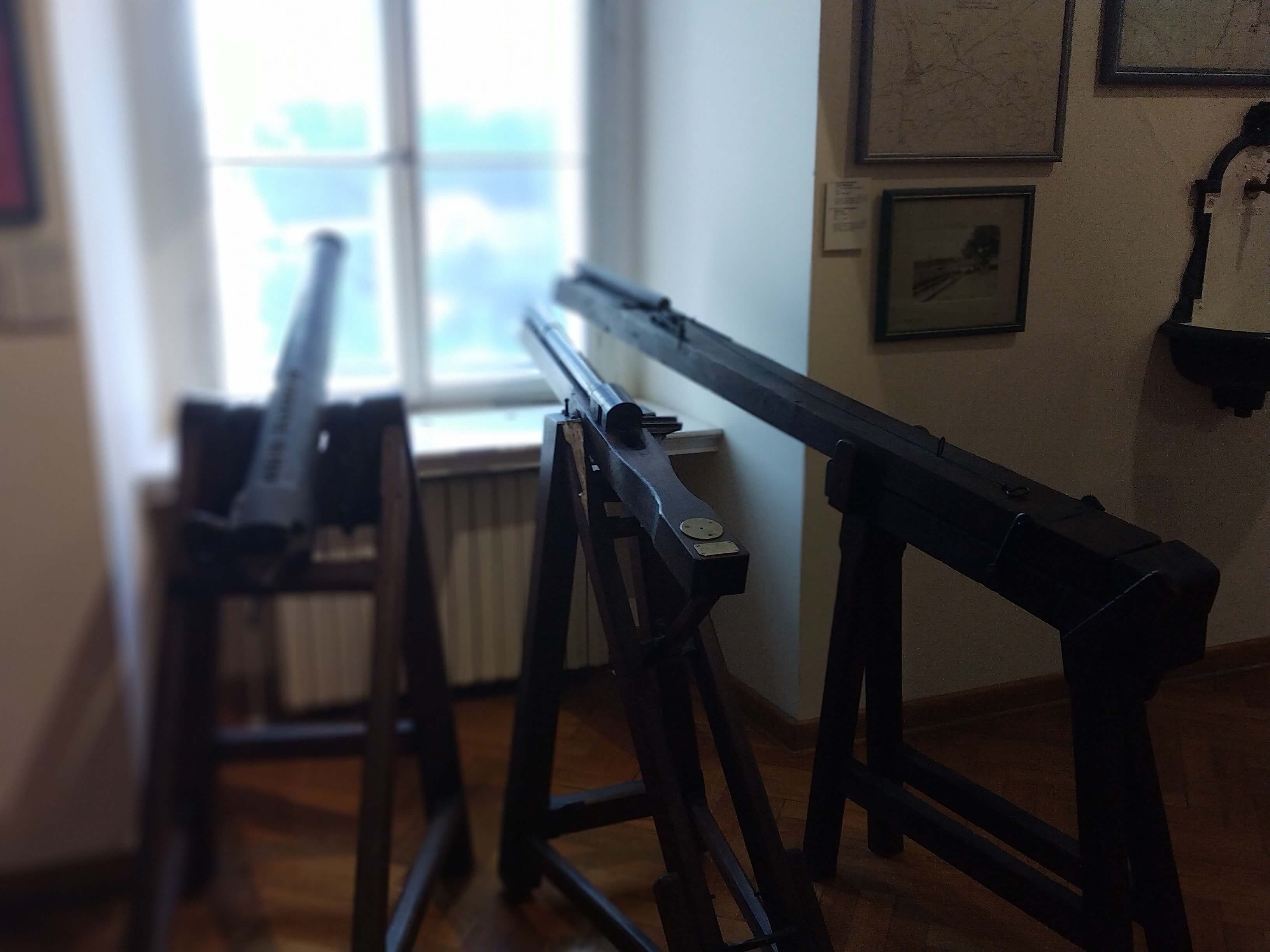
Three cannons showcased at Zagreb City Museum © Ivor Kruljac / Total Croatia News
So finding yourself in front of Fort Lotrščak (whose entrance is located right next to the Upper town funicular station) is not recognizable if you are not a fan of loud noise as it can give you a sound fright even down below at Jelačić square and the surrounding area. But, for the brave ones, the Grič cannon can provide a unique souvenir from Zagreb. It doesn't use live ammo (the cannon is modified so it can't), but it does fire several pieces of thick cardboard that then flies down to the area underneath Lotrščak's entrance and smelling like gunpowder.
Ceased fire
Despite being a regular background sound for the experience of living in Zagreb, Grič cannon went through periods when it ceased fire and stopped making statements. The first such instance was World War I and then followed by the war in the nineties. Most recently, the cannon was silenced after the Zagreb earthquake on March 22, 2020, but it re-fired hot and heavy sometimes in May 2020. However, followed by the December 29th Petrinja earthquake, which was also felt heavy in Zagreb, the cannon is silent even today.
„We are not quite sure when it will re-fire“, briefly commented the Zagreb Tourist Board member that welcomed me in Fort Lotrščak, one of the locations where Zagreb TB has a regular stand. Still, despite the cannon being silenced, you can climb and sightsee Lotrščak, the famous cannon as well as the watchtower on top of the Fort, for the prize of 20 kunas.

One of the exhibitions at Lotrščak © Kula Lotrščak
The Lotrščak Fort address is Tomićeva 9, and the Fort occasionally also hosts various exhibitions at times too. But, the cannon is a regular feature, and there are lots of info on the history of the cannon and the Fort itself there too on the walls- both in English and Croatian.
Learn more about Zagreb on our TC page.
For more about history in Croatia, follow TCN's dedicated page.
Maritime Welfare in Croatia: Drvenik Case and What Law Says
June 25, 2021 - The issue of maritime welfare in Croatia was raised once again after a heated discussion on a beach in Drvenik Veli. Here are the details of the case and legal guidance to the maritime welfare in Croatia.
With the 2021 tourist season already being 58% better than 2020, tourists once again visit Croatia as one of the top holiday destinations.
However, like any year, the season can't go without at least some sort of incident.
Lovely beach, disgusting words
Yesterday, Croatia was shocked and enraged with the incident that happened on a beach on Drvenik Veli island (not so far from Trogir). Croatian journalist Tonka Alujević and her friend went to a beach where two Czech tourists started complaining that it's a private beach, perks of paying for a villa, and that Alujević needs to leave. Alujević refused to leave, stating that beaches are maritime welfare and cannot be privatized, refusing to move. After, as Alujević claims Czech tourists hit her head with a phone, they called the villa owner. 24 Sata daily newspaper published a video Alujević's friend recorded.
„Ma'ams, Ma'ams, how did you get here? On foot?“, asked the owner on a phone that was on speaker and held by the Czech tourists.
„I'm a journalist. Do you know Croatian laws? Do you want to end up in media?“ replied Alujević with a chill face while smoking a cigarette on a sunny day at the beach.
„Come on, put me in the media, come on put me! But first, go to the land register and see that my beach is private," screamed the owner in Croatian, with a lot of derogatory phrases (if only Czech tourists had a translator to understand the rich swear word heritage of Croatian language, right?)
The whole thing ended up with inspection stepping on the scene. Despite the video footage being clear, the owner, identified by Index.hr as Tomislav Meštrović, owner of Centovi Dvori Villa, tried to justify himself, saying everyone is welcomed at the beach, and he attacked the women because they passed through his doorway.
„No, I have no idea what video, who what... who knows what that is... I called the police for trespassing through my land“, said Meštrović to Index.hr when asked about the footage.

the conversation at the beach, screenshot/ 24sata
Law and order
Following this story, Index.hr's columnist Goran Vojković analyzed the law to clear up the issue of maritime welfare.
„The Maritime Welfare and Sea Ports Law states 'at least six meters from a line horizontally distant from the line middle waters'. But it can be wider, for example, if part of the land that in its nature or use serves to exploit the sea. It can also be narrowed- for instance, if support walls or a public road are close to the sea“, Vojković listed general rules but adding that maritime welfare border is specifically determined.
„So, the coast is free to use where the beach is, in general, six meters. You can come and use it for your needs, such as bathing, tanning, or walking. The land behind can be private, but the coast cannot“, concluded Vojković.
On the other hand, there are ways to limit the use of maritime welfare.
„There are some parts of the coast where you cannot enter. You can enter the marina and walk around it, but only until 10 pm. You cannot enter at all in a shipyard port. Those are the parts of maritime welfare for which the state assigned a concession to someone. The concession can limit or terminate public use“, explained Vojković.
Additionally, the law states that it is possible to have a beach in its concession and limit public entrance. But it needs to be registered, and the prices are so expensive that there are very few beaches like this in Croatia (Drvenik one not included in that small list).
„If someone claims that has a concession and that he/she can exclusively use some part of the coast, he needs to have a proof you can easily check in the register. I repeat, there are very small examples; even beaches in front of five-star hotels are public good“, Vojković pointed out.
And such beaches are filled with deck chairs, food stands, etc. But as Vojković pointed out, on a public beach, you have the right to bring your own deck chair, your own food, and drinks, and you can't be forced to consume content on the beach.
„In short, enjoy the Adriatic coast- with some very small exceptions of exclusive concessions, the entire coastline (including island coast) is free for your use and joy. Nobody can hold a grudge or complain if you came to a bath where they think it's 'their' beach. If someone is uncomfortable, don't debate, call authorities“, advises Vojković.
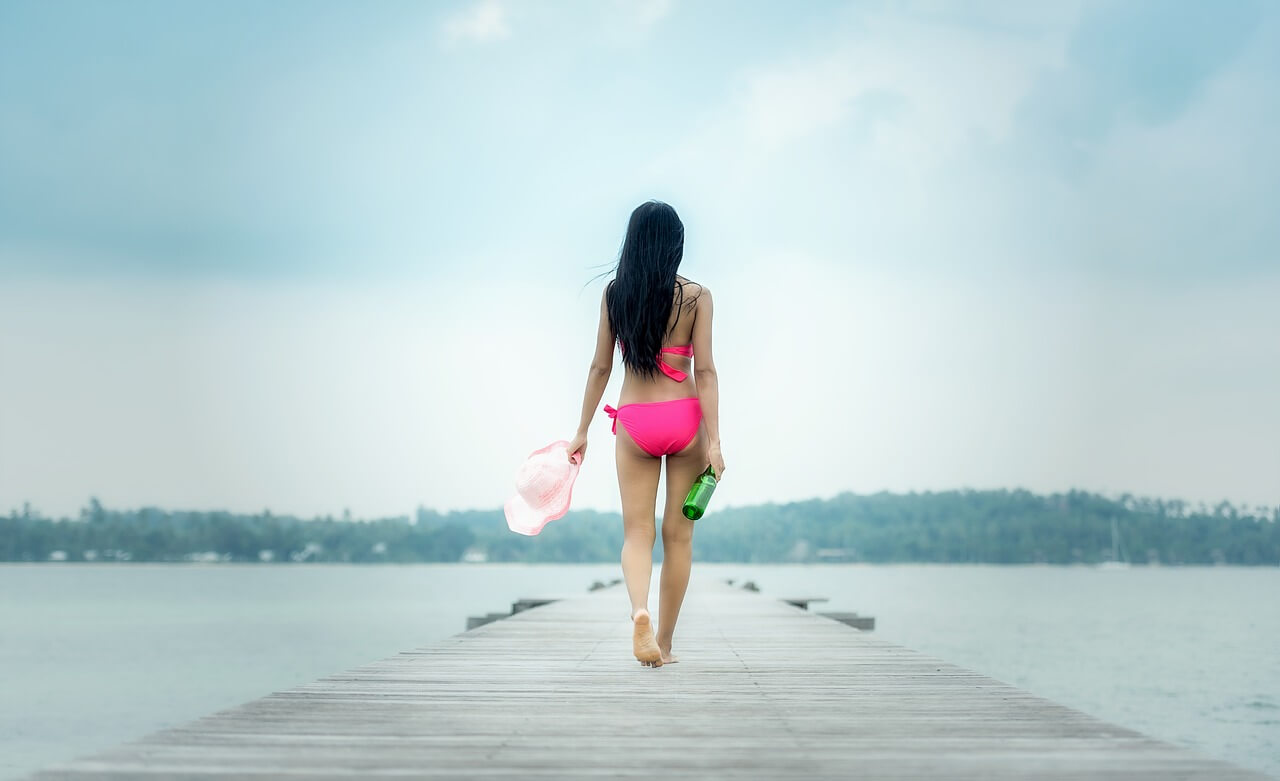
Pixabay
And the beach is open for public happily ever after
As Jutarnji List reported, the Drvenik case has a conclusion to an intriguing plot. Unhappy with Meštrović's behavior, Dalmatian locals went vigilantly and started writing bad reviews on Google, seeing the villa losing its value and tourists.
„Even though neither the building, nor its surroundings changed since the video was released, the unkindness of the owner was enough to move once-prestigious villa to the lowest grading Croatian places on Google“, says Jutarnji.
A couple of more lessons can be learned for a successful and enjoyable season from this tale.
For owners: present your offer fair in accordance with the law as transparency is the best way for your offer to beat the competition.
For tourists: if you were promised a private beach, but you see locals coming, don't be rude to them and don't attack them. The only one you can really be mad at is your host, who perhaps lied about what they can truly provide.
Learn more about beaches in Croatia on our TC page.
For more about travel in Croatia, follow TCN's dedicated page.


